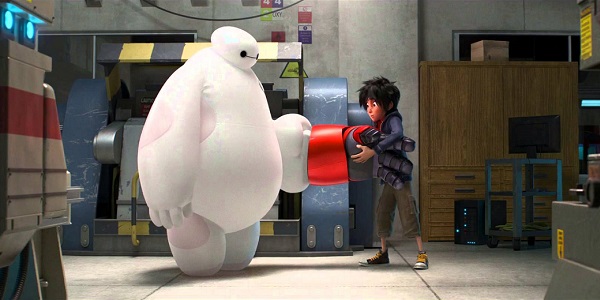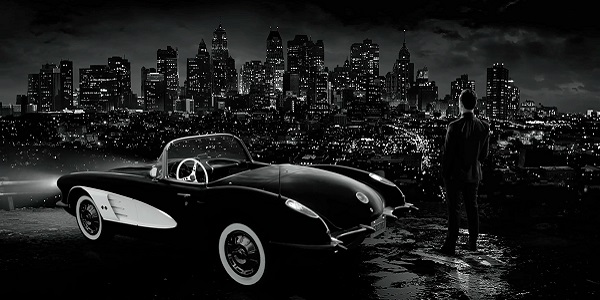Big Hero 6 (2015)
January 5, 2015 Leave a comment
 In downtown San Fransokyo, 14-year-old Hiro Hamada (Ryan Potter) is making quite the name for himself — and a fair amount of pocket money — as an illicit robot fighter. Worried for his younger brother’s future, university student Tadashi (Daniel Henney) takes him along to the campus’ robotics laboratory to try and inspire him to put his talents to better use and perhaps even enroll himself. Before Hiro can register, however, a fire breaks out at an annual exhibition killing Tadashi. Hiro’s pain activates Baymax (Scott Adsit), a personal healthcare robot Tadashi was developing when he died, and the two bond over an investigation into the fire’s origins that Baymax believes will aid the healing process. Together with his brother’s old classmates — GoGo Tomago (Jamie Chung), Wasabi (Damon Wayans Jr), Honey Lemon (Génesis Rodríguez) and Fred (T J Miller) — Hiro and Baymax confront the man they believe to be responsible for Tadashi’s death.
In downtown San Fransokyo, 14-year-old Hiro Hamada (Ryan Potter) is making quite the name for himself — and a fair amount of pocket money — as an illicit robot fighter. Worried for his younger brother’s future, university student Tadashi (Daniel Henney) takes him along to the campus’ robotics laboratory to try and inspire him to put his talents to better use and perhaps even enroll himself. Before Hiro can register, however, a fire breaks out at an annual exhibition killing Tadashi. Hiro’s pain activates Baymax (Scott Adsit), a personal healthcare robot Tadashi was developing when he died, and the two bond over an investigation into the fire’s origins that Baymax believes will aid the healing process. Together with his brother’s old classmates — GoGo Tomago (Jamie Chung), Wasabi (Damon Wayans Jr), Honey Lemon (Génesis Rodríguez) and Fred (T J Miller) — Hiro and Baymax confront the man they believe to be responsible for Tadashi’s death.
The 54th film in the Disney Classics series, following 2013’s indomitable Frozen, Don Hall and Chris Williams’ Big Hero 6 is the first to draw from Marvel Comics’ extensive back catalogue, which the studio acquired in 2009. It is a loose adaptation of a relatively obscure title created by Steven T Seagle and Duncan Rouleau, with the film’s screenwriters severing ties with the wider Marvel Cinematic Universe (as well as Sony’s Spider-man and Fox’s X-Men) in order to focus on the relationship between a young boy and his late brother’s legacy. Disney and Marvel, however, make for awkward bedfellows; the first act is an overcomplicated mess of technobabble and schmaltz as the film tries to meet the demands of two very different audiences, one expecting traditional fairytale values while the other anticipates pixilated superhero spectacle. However, while Pixar can condense and concentrate a life-time of love and loss into a ten minute montage or serve up space-faring set pieces at a moment’s notice their parent company can’t help but make a meal of it.
Fortunately, once the introductions, motivations and machinations are out of the way the characters and relationships begin to speak for themselves. This change roughly coincides with the arrival of Baymax, at which point the pace, the tone and the energy of the piece all pick up considerably. In the space of a single scene Hiro has found a renewed purpose, the film has reconciled its competing codas and audiences have a new favourite robot. From the moment he squeaks onto screen, squeezing past Tadashi’s bed and knocking over all of his books, an icon is born. A cross between an airbag and an iPod, Baymax — who bears little resemblance to the Battle Dragon from the source material– is completely irresistible, proving a consistently amusing presence in his own right while simultaneously bringing out the best in everyone around him. Hiro’s exchanges with Baymax are hilarious, honest and heartfelt; the complete opposite of his trite altercations with Tadashi. Indeed, their best scenes together — in Hiro’s bedroom diagnosing puberty; reporting a preposterous crime to a skeptical police officer; returning home apparently drunk and disorderly — go some way towards compensating for their worst scenes apart.
And then, two acts too late, Big Hero 6 suddenly remembers that it’s supposed to be a superhero movie. Having already upgraded Baymax with Iron Man-esque technology, Hiro turns his attention to what had previously been little more than the supporting cast. GoGo Tomago, Wasabi, Honey Lemon and Fred are all eye-catching and unique characters (though apparently from the Power Rangers school of colourisation), but given that they each constitute one sixth of the eponymous super-team they feel more like canon fodder than core members. That said, they’re undoubtedly impressive in action, helping to ensure that each set piece is imbued with as much spirit as it is spectacle — Jamie Chung and T J Miller in particularly making the most of every line of dialogue. Ultimately, however, this is Hiro’s story and Baymax’s movie, and inevitably it all comes back to them. The film has some surprisingly complex things to say about grief and maturity, and a number of twists and turns keep things interesting though the third act, but the appeal of their relationship is as much to do with flying really fast around the diverse and beautifully designed streets of San Fransokyo as it is about their capacity for foregrounding mental health and mortality.
A story of three halves, Disney’s latest struggles to define itself as either a family drama, a buddy comedy or a superhero origin story. By the time Baymax enters the fray and Hiro finally founds Big Hero 6 the film is already beset by structural issues that prevent it from ever really hitting its stride. It has its moments, undoubtedly, but in the end it’s neither an official Marvel film or a true Disney Classic.






